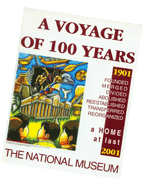RESTORATION AND ENGINEERING DIVISION

Function
Scientific architectural research, study and documentation in the preservation, conservation and restoration of immovable cultural properties and national cultural treasures; Specialty architectural services in the preservation, conservation and restoration of immovable cultural properties and national cultural treasures; Specialty architectural services in the repair, maintenance of museum buildings, field stations and museum related infrastructures; Specialty architectural services in exhibition design for museum galleries.
Historical Notes
Monuments and museums, sites and shrines - these are some of the cultural landmarks that must be preserved and maintained through all of history. This is why the Restoration and Engineering Division was formed.
The former Restoration and Conservation Division was created in 1974 by the signing of P D. 260, a law providing for the preservation of national cultural properties. It started as an "ad hoc" function with Architect Leonardo Concepcion as the only employee. After a year, Benito A. Cagahastian and Oscar Villaruz were appointed to the positions of Supervising Architect and Museum Researcher, respectively.
Cognizant of the volume or quantity of work to be accomplished by this tiny group, six more persons were added in 1976. In 1987, by virtue of Executive Order 117, a reorganization program was implemented. A maintenance unit was integrated with the Division, thus necessitating the change of its name to Restoration and Engineering Division with Engr. Eugenio C. Magboo, Jr. as Head.
This development signaled the start of a more aggressive stance towards museum planning and development. At present, the Division counts a manpower strength of 22 employees, all technically equipped to fulfill the demands of the Division and the objectives of the Institution.
Turning Points
For the most part, restoration and rehabilitation works top the agenda of the Restoration and Engineering Division. In this respect, the Division has two extraordinarily significant projects, survey, construction, and development of the so-called mummy caves in Benguet Province and the improvement of the Tabon Caves in Palawan.
Considered the most striking historical event for the Division was its major participation in the rehabilitation of the National Museum Main Building with more complicated civil and engineering works and a capability to withstand strong earthquakes, typhoons, and similar natural phenomena
A Broader Role
The statutory functions of the Restoration and Engineering involve research, survey, and documentation. Specifically, it undertakes the survey and actual measurement of immovable landmarks, museum properties and sites for purposes of data compilation, and prepares case studies on conservation of architectural heritage.
The Division is also concerned with the physical planning program of the National Museum wherein it prepares the plans, working drawings and structural computation for proposed projects of the agency, and performs the construction and development of the Museum Building, field offices and branches, and landscape.
The Division likewise provides educational support to students and researchers about the principles of basic museum planning and design. It renders technical consultancy to other government agencies or private institutions and individuals regarding museum/exhibit set-up and proper implementation of restoration works.
The Restoration and Engineering Division is anchored on safe and strong grounds, and founded with the right attitude, the right values and the right technology. Its achievements in the preservation of our national cultural heritage are steps in the right direction. But through timely and consistent support from the leadership of the National Museum, as well as from national and local government, projects will continue to move forward with precision.
taken from the
"A Voyage of 100 Years"



